Table of Contents
The experimental blast furnace has attracted increasing interest during the past decade as a practical means for investigating a broad range of blast-furnace smelting problems. Under experimental-furnace conditions, information can be obtained with less expenditure of time and raw materials and, therefore, at lower cost than comparable information could be obtained under industrial operating conditions. Furthermore, the experimental furnace may be operated beyond the range of smooth operation, even to failure, to delineate the limits of operability. Such deviation from normal operating practice would be economically intolerable in industrial operations where production and operating stability might be disrupted.
The Federal Bureau of Mines experimental blast furnace at Bruceton, Pa., near Pittsburgh, has been operated and under development since 1951. However, the usefulness of this experimental data to industrial practice was somewhat nebulous in early experiments, and the correlation of the experimental blast furnace with the industrial blast furnace was not known.
To bridge this deficiency, for about 2 years (1955-57), operations were directed toward showing that test conditions and operating results obtained with the experimental blast furnace could be duplicated from one series of tests to the next. Then, during the period May 15 to September 21, 1957, tests were carried out comparing the experimental 4-foot-hearth blast-furnace operations directly with the industrial 28-foot-hearth blast-furnace operations.
Available information indicated that the maximum wind rate that could be applied effectively on the Fairless furnace was 85,000 standard cubic feet per minute when 50 percent of the ore burden was soft sinter. Above this wind rate, stock movement became irregular and metal analyses were erratic. With the experimental furnace burdened with identical raw materials and operated so that items such as coke rate, slag volume, slag basicity, and metal composition closely paralleled Fairless results at 85,000 standard cubic feet per minute wind rate, it was found that the maximum wind rate that could be applied effectively to the experimental furnace was 900 standard cubic feet per minute. Therefore, the indicated correlation factor for maximum operable wind rate was approximately 95 to 1. This factor was then used for the remainder of the tests to determine the wind rate to be applied to the experimental furnace to approach comparable driving conditions.
Further correlation factors were attained by operating the experimental furnace on a second burden the same as that which is used in the Fairless furnace and in the South Works furnace of the United States Steel Corp. The same grade and types of raw materials as those used in industrial furnaces were smelted in the experimental furnace. Experimental operations were maintained in the range where gas flow and stock movement were quite smooth and regular. Then, data on metal production, wind rates, blast temperature, pressure drop in the stock column, and dry dust load in the effluent gas were compared with industrial-furnace equivalents. The correlations of a 28-foot-hearth furnace with the 4-foot-hearth furnace showed that wind rates and production rates for industrial furnaces may be some 95 times those of the experimental furnace; the blast temperature, two-thirds to three-fourths that of the experimental furnace; and dry dust, 1-1/3 times that of the experimental furnace.
When work was directed toward showing that test conditions and operating results could be duplicated, information was also developed on such subjects as: (1) Producing spiegeleisen from open-hearth slags to recover manganese, (2) replacing coke by anthracite in the fuel burden, (3) smelting titaniferous ores, (4) smelting raw unfired pellet agglomerates, and (5) smelting various blends or combinations of domestic and foreign ores in the natural or processed states.
Experimental Facilities
The facilities for the experimental work consisted of an experimental blast furnace and auxiliary equipment for supplying, heating, and humidifying the air blast; drying, screening, and charging raw materials; and disposing of iron and slag products. Instrumentation was provided for automatic control of blast temperature, air-blast heating, and air-blast humidity. Cold-air volume was controlled manually and measured with an orifice-type flowmeter. All equipment was tailored in size and performance characteristics to conform with the expected range of operations that were to be carried out in the experimental furnace.
The experimental furnace conformed to the general lines of industrial blast furnaces. However, it was not scaled down equally in all dimensions but was designed with a stack height and internal diameter such that solid retention time would be approximated by operating in the lower range of wind rates. Gas velocity would be approached at the upper range of the air-blast volumes that could be applied to the experimental furnace.
Figure 1 shows the major dimensions of the furnace used in these experiments.
The working height of the furnace was 21 feet 4 inches from the center line of the tuyeres to the stockline. The internal, or working volume, approximated 327 cubic feet between the tuyeres and the stockline. Three tuyeres, of 1-¾-inch nozzle diameter, were spaced at 120° intervals. The furnace top was equipped with a revolving receiving hopper for distribution of stock materials, large and small bell compartments for passage of raw materials into the furnace shaft, and two outlets on the furnace top for exhausting the gaseous products.
Experimental Operations
Metal production rate and coke consumption are the most important items in the economy of blast-furnace operations. The rate of production depends on the iron content of the ore and its throughput, which in turn depends on the wind rate that can be applied effectively. Coke consumption on a unit production basis, usually expressed as pounds per ton of hot metal, is determined almost entirely by the maximum burden ratio that can be smelted for a given wind rate and blast temperature. For this investigation, the plan was to operate at burden ratios similar to those used in industrial furnaces, then to determine the maximum wind rate at which smooth operation could be maintained while producing metal of industrial quality.
Three distinct raw-material burdens that had been used industrially in 28-foot-diameter hearth furnaces of the Fairless and South Works plants of the United States Steel Corp. were smelted in the Bureau’s experimental furnace. Table 1 gives the relative physical characteristics of the experimental and industrial furnaces and table 2, the main constituents of the materials used.
The diversity in composition of the materials, as shown in table 2, indicates the wide area of comparative operations investigated. Fixed carbon in the Fairless coke was 90.8 percent and in South Works coke, 91.6 percent. The ash contents for Fairless and South Works cokes were 8.3 and 6.8 percent, respectively. Limestone and dolomite were sized to 15/16 inch by 2 inches and ¾ inch by 1-7/8 inches, respectively. All coke was sized to ¾ inch by 2 inches.
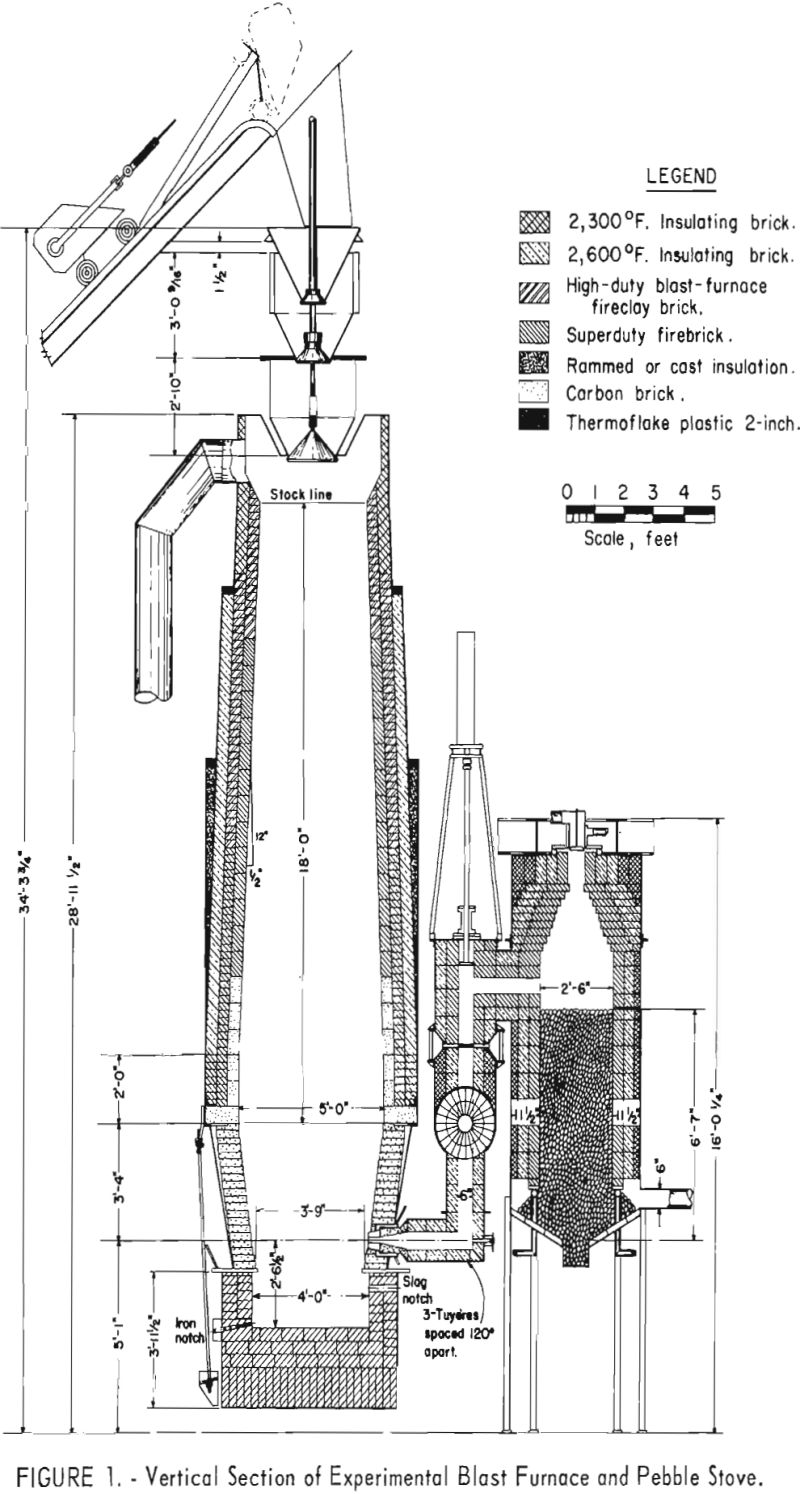

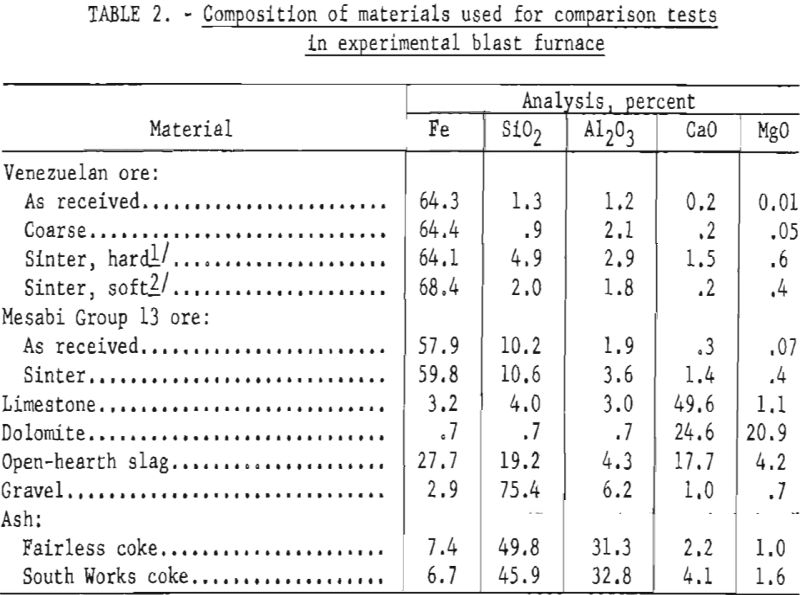
Proportions of the various burden constituents in the test series are shown in table 3.
Information was available on maximum wind rate at the Fairless furnace, in which 50 percent of the ore burden was soft sinter. The maximum wind that could be applied effectively while operating on this burden was 85,000 standard cubic feet per minute. Stock movement became irregular, and metal analyses were erratic when this wind rate was exceeded. The experimental furnace was burdened with identical raw materials and was operated so that items such as coke rate, slag volume, slag basicity, and metal composition closely paralleled the Fairless results at the 85,000 standard cubic feet per minute wind rate. In this test the wind rate was increased progressively to determine the maximum rate for smooth operation.
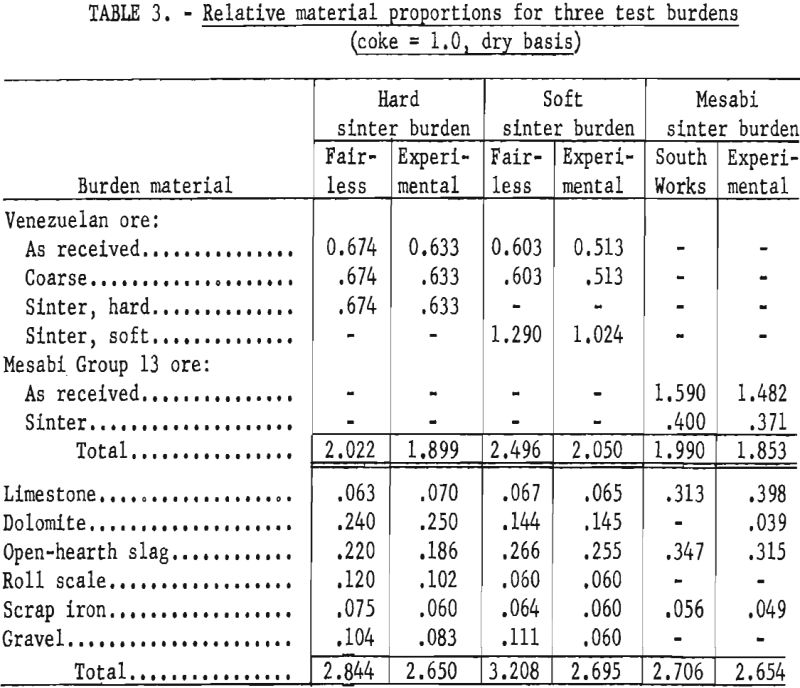
The experimental furnace was brought into stable operation on the Fairless soft sinter burden (50 percent sinter, 25 percent screened ore, and 25 percent as-received ore) at 600 standard cubic foot per minute wind rate and 1.95 burden ratio, ore to coke. Then the wind rate was increased 50 standard cubic feet per minute at 24-hour intervals, until stock movement was irregular and metal analyses were erratic and the furnace became inoperable. The maximum operable wind level for the experimental furnace on the described burden was 900 standard cubic feet per minute. Table 4 shows the similarity of the mentioned items for the two furnaces, industrial and experimental, at the respective maximum wind rates.
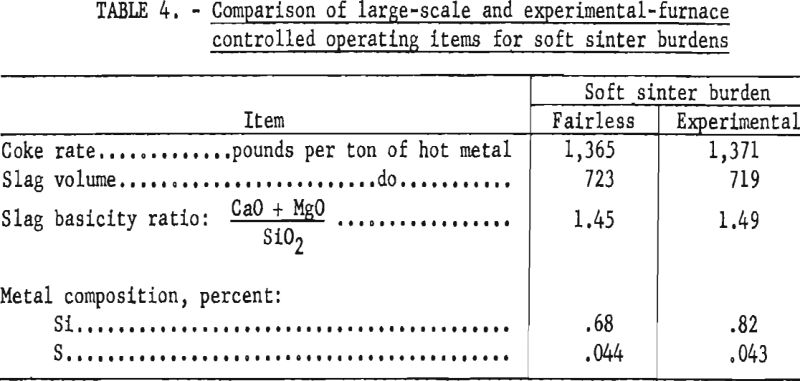
Therefore, the indicated factor for maximum operable wind rate was approximately 95 for transposal from the experimental furnace to a 28-foot hearth-diameter blast furnace (that is, 85,000 divided by 900).
Wind rate was the only item suitable for correlation on the soft sinter burden because of the relatively short time that the Fairless furnace was operated at the 85,000 standard cubic foot per minute wind rate. However, extensive data were available from industrial operations on the Fairless hard sinter and the South Works Mesabi burdens. The experimental furnace was operated on these burdens at conditions that paralleled the driving rates, coke consumption, slag volumes and basicities, and metal composition of the large furnace operations. The previously derived factor for relating wind rates in the small and large furnaces (one ninety-fifth of the industrial furnace wind rate) then was used to determine the wind rate to be applied to the experimental furnace to approach comparable driving conditions. The elements of coke and slag rates, slag basicity, and metal composition were controlled closely to make them match the industrial furnace conditions by burdening them with identical raw materials at nearly equivalent weight ratios per charge.
The experimental furnace was operated on the Fairless hard sinter burden at a wind rate of 1,050 standard cubic feet per minute (one ninety-fifth of the 100,000 standard cubic foot per minute Fairless rate) and to a coke rate of 1,344 pounds per ton of hot metal. The operation on the South Works Mesabi burden was at a wind rate of 960 standard cubic feet per minute (one ninety-fifth of the 91,000 standard cubic foot per minute South Works rate) and to a coke rate of 1,578 pounds per ton of hot metal. The similarity of data for the various items of the experimental and industrial furnaces (28- foot hearth) is shown in table 5.
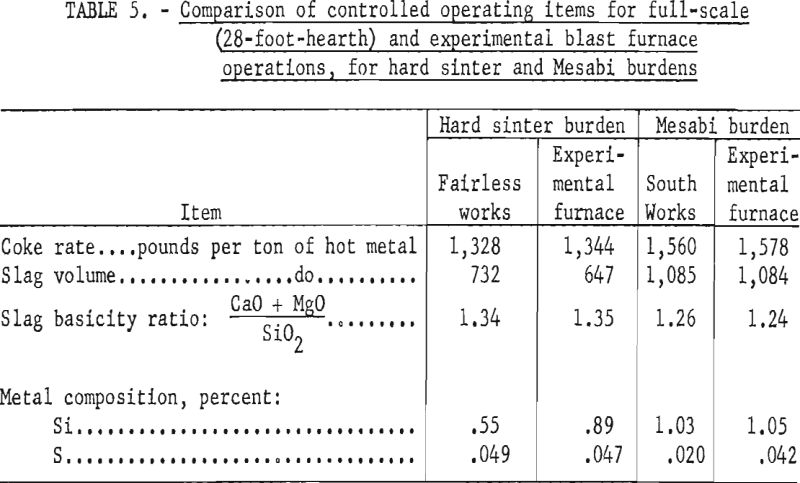
Discussion of Results
By controlling the operating conditions of the experimental furnace so that they were nearly similar to industrial conditions, data were obtained on production rate, hot blast temperature, dry dust rate, and pressure drop. The pressure-drop comparison is based on the difference between the tuyere and top pressures for each furnace. The relation of industrial-furnace data to experimental-furnace data is shown in table 6.
The factors relating the experimental furnace results to industrial operations agree closely for the hard sinter and Mesabi burdens. Therefore, the approximate factors for translating experimental data to full-scale operations on the 28-foot-hearth furnaces are: Production rate, 95; pressure drop, 3.6; dust rate, 1.33; and hot blast temperature, 0.7 to 0.8.
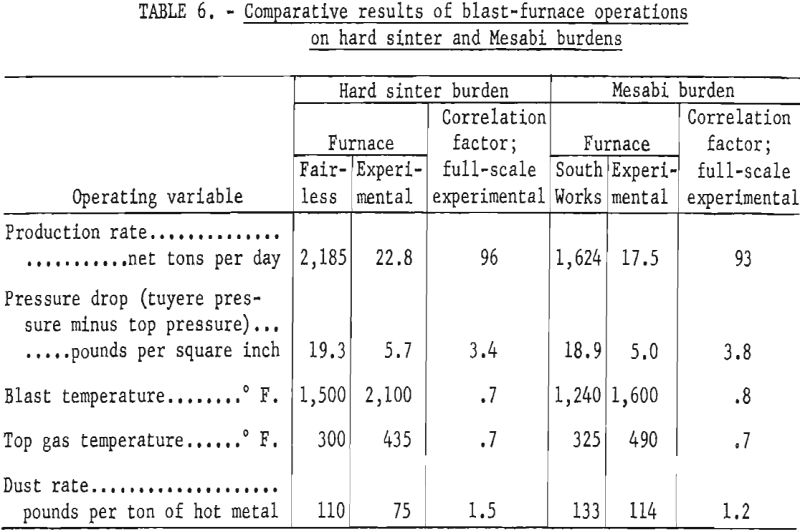
These correlation factors provide a basis for applying information on experimental operations to industrial blast furnaces for new or unusual burden materials, different slag compositions, various combinations of raw materials in the furnace burden, and different operating techniques. The experimental furnace, therefore, is a practical facility for obtaining preliminary information on raw materials of unknown smelting characteristics under operating conditions that might deviate considerably from normal industrial practice. From results of experimental-furnace operations on new raw materials using various operating techniques, items such as coke rate, metal production, dust rate, pressure drop, hot blast temperature, and maximum wind rate can be reasonably predicted for industrial-furnace operations. This information may be obtained quickly and economically in the experimental unit, whereas in industrial operations the information must be developed in increments over extended operating periods to avoid dislocation of normal production activity.
